September 2011. Windowless conference room in Deloitte’s Atlanta office. First week at my first “real job,” staring at retirement plan enrollment forms.
Fresh out of college with a finance degree, I should’ve been breezing through this. But I kept hitting a mental roadblock: when trying to choose between a traditional 401(k) or a Roth, one line in the guidance doc said “if you expect to make less money in retirement than while working, choose the traditional.”
What? Less money in retirement?
That seemed completely backwards. Why would decades of hard work lead to a smaller paycheck and a reduced lifestyle? I assumed I was missing something obvious.
Seeing Through the Game
Several years later, after reading Rich Dad Poor Dad, it finally clicked: I wasn’t missing anything…I was seeing straight through the Wall Street game.
I heard someone recently describe this as “the deferred life plan,” and that’s about as accurate as it gets.
It typically looks like:
Max out your 401(k) contributions
Hope the market cooperates over 30 years
Accept the 10% early withdrawal penalty as “just how it works”
Wait until the government says you’re old enough to access your wealth
Penny-pinch in your golden years, praying you don’t run out of money
This plan promises security but delivers decades of sacrifice followed by scarcity.
If you’re a decade or two into your career wondering why financial freedom still feels impossibly distant despite doing everything “right,” this is why.
The False Choice
This traditional path forces you to choose between your current quality of life and future security.
Want to take a year off to travel with young kids? Irresponsible. That passion project you’ve been thinking about? Better wait until retirement. After all, every dollar you don’t save now means less compounding for the future, right?
You’re told this tradeoff is unavoidable. Sacrifice now or sacrifice later. Pick your poison.
But there is a third option.
Why Cash Flow Changed Everything for Me
When I first discovered Kiyosaki’s concept of investing for cash flow, it hit me hard.
Because it answered the question I’d been asking since that conference room: you don’t have to plan for less in retirement. You can build for more.
Cash flow from real estate does something the traditional model can’t: it gives you money to use right now without sacrificing your future. You’re not choosing between today and tomorrow – you’re funding both simultaneously.
This is what eventually led me to commercial real estate, and specifically why I love syndications for passive investors:
Quarterly distributions provide money you can use for lifestyle or reinvest
Long-term appreciation through debt paydown and forced appreciation builds wealth you never have to touch
Tax advantages that can exceed traditional retirement accounts
Not to mention infinite return strategies through refinancing that let you redeploy the same dollar multiple times (which you can’t do in the stock market).
What to Do About It
If you’re already heavily invested in the traditional model, you don’t have to blow everything up. Start moving portions toward cash-flowing assets. Use an IRA to invest in real estate syndications if you want. Start building the cash flow side while maintaining what you’ve already got.
If you’re earlier in your career with good income and decades ahead of you, the opportunity is even bigger. You can build a portfolio designed from the ground up to generate cash flow today while still capturing long-term appreciation and tax benefits.
Making More in Retirement
Remember my question in that conference room…why would I plan to make less money in retirement?
The traditional model requires it. When your wealth exists only on paper and you have to sell your assets to create income, you’re naturally forced into a lower standard of living to keep from “outliving your money.”
Cash-flowing assets let you reject this premise entirely. Over time, they can generate income that matches or exceeds what you make from your job – income that comes from the assets themselves, not from selling them off.
But most people never question the assumption. They follow the herd, hope for the best, and wonder decades later why they’re wealthy on paper but constrained by what they can actually do.
You can have cash flow today AND wealth tomorrow. You just need to invest in assets that do both.
